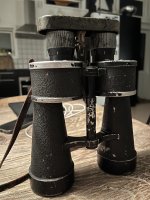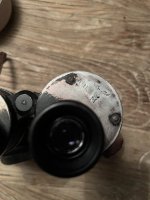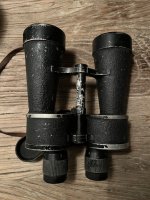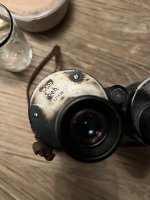-
Welcome to BirdForum, the internet's largest birding community with thousands of members from all over the world. The forums are dedicated to wild birds, birding, binoculars and equipment and all that goes with it.
Please register for an account to take part in the discussions in the forum, post your pictures in the gallery and more.
You are using an out of date browser. It may not display this or other websites correctly.
You should upgrade or use an alternative browser.
You should upgrade or use an alternative browser.
Zeiss WW2 Binocular, help needed (2 Viewers)
- Thread starter RasmusBH
- Start date
More options
Who Replied?Hermann
Well-known member

Not a Zeiss. The code name for Zeiss was "blc", this is a "beh", the code name for Leitz. Have a look here: Leitz - beh U-Bootglas 7x50
Hermann
Hermann
Pinewood
New York correspondent

Hello,
This is a Porro II binocular. If coated, it a very nice binocular, if in collimation. I think that yours lacks coating. The Porro II design allowed for higher light transmission than the Porro I binoculars. Yours is quite light compared to Porro I binoculars. I
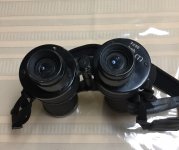 attach a photo of mine, which was restored and de-nazified. The (T) indicates coating.
attach a photo of mine, which was restored and de-nazified. The (T) indicates coating.
Stay safe,
Arthur Pinewood
This is a Porro II binocular. If coated, it a very nice binocular, if in collimation. I think that yours lacks coating. The Porro II design allowed for higher light transmission than the Porro I binoculars. Yours is quite light compared to Porro I binoculars. I
 attach a photo of mine, which was restored and de-nazified. The (T) indicates coating.
attach a photo of mine, which was restored and de-nazified. The (T) indicates coating.Stay safe,
Arthur Pinewood
Last edited:
John A Roberts
Well-known member

An advantage of such long old style binoculars is their mass distribution and hence in-hand balance, as an aid to steady holding.
See Tobias’ article on various long, standard and squat x50 Zeiss models: Vintage 8x50s binoculars from Zeiss Jena and Oberkochen
Two cropped images from the article:
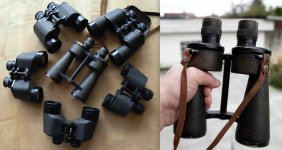
John
See Tobias’ article on various long, standard and squat x50 Zeiss models: Vintage 8x50s binoculars from Zeiss Jena and Oberkochen
Two cropped images from the article:

John
Pinewood
New York correspondent

Hello dries1,Nice glass, question, how is the view?
As I have a clean, coated version of this Leitz beh, I am taking the liberty of answering your query. It has a slightly wider FOV than contemporary American naval binoculars, like the mark 32's, and similarly poor relief. I can focus to infinity with my right eye but not quite with my left eye. As John Roberts wrote, it is rather light. I suspect that glasses with modern coating would be brighter and have more contrast but it does provide a pleasing view.
Edit: This binocular is regarded as more fragile than contemporary Porro binoculars.
Stay safe,
Arthur
Last edited:
Pinewood
New York correspondent

Hello Dries,Thanks Arthur, I have seen a few of these, but the view was obstructed, (the dreaded fungus) and assorted debris. Clean samples like yours are quite rare.
There was a German 7x50 model with drying canisters, which may have resisted the fungus problem. I cannot recall if it was Leitz or a Zeiss model.
Stay safe,
Arthur
I always wondered why the Porro II design was not more popular. It seems easier to make slimmer binoculars (shaped more like roofs), that the market favours, such as the Canon IS series (which are in fact Porro IIs, IIRC) with this design, while not (presumably?) requiring the very tight tolerances of roof designs. I've read that the prisms being unsupported (?) were more vulnerable to shock, but one would have thought some method of support could have been devised - and birding or general nature observation wouldn't require the shock resistance of a marine binocular.
I wonder if the advantage of a long binocular in steadiness is in having more to grip/change your grip, as much as actual balance or weight distribution. At one point the trend was very much towards short porros (Zeiss West and CZJ porros with air spaced tele-objectives, some of which are featured in the link to Tobias's site). I find long roof binoculars like the 7x42 Dialyt steadier than those; but think it's more the roof design (barrels closer together) than the length, as I get along well with shorter roofs quite well.
I wonder if the advantage of a long binocular in steadiness is in having more to grip/change your grip, as much as actual balance or weight distribution. At one point the trend was very much towards short porros (Zeiss West and CZJ porros with air spaced tele-objectives, some of which are featured in the link to Tobias's site). I find long roof binoculars like the 7x42 Dialyt steadier than those; but think it's more the roof design (barrels closer together) than the length, as I get along well with shorter roofs quite well.
Last edited:
Pinewood
New York correspondent

Hello Patudo,...
I wonder if the advantage of a long binocular in steadiness is in having more to grip/change your grip, as much as actual balance or weight distribution. At one point the trend was very much towards short porros (Zeiss West and CZJ porros with air spaced tele-objectives, some of which are featured in the link to Tobias's site). I find long roof binoculars like the 7x42 Dialyt steadier than those; but think it's more the roof design (barrels closer together) than the length, as I get along well with shorter roofs quite well.
I think that the longer barrels on the Porro II and on the 7xr42 Dialyt simply give the user an opportunity to find his own sweet spot for handling. As John Roberts suggests, the Porro II binoculars may have better weight distribution.
It would also seem that the objective lenses generally have longer focal lengths, depressing chromatic aberrations.
With the exception of the Zeiss 7x50 Septarem, Porro II binoculars are generally individual focus, not the best for bird watching.
Stay safe,
Arthur
The "beh" was the late wartime code for E.Leitz Wetzlar. The "ARTL" signifies Naval Artillery.
These are very good glasses, but because of the prism design, can be a little fragile.
Its optical performance is simply excellent. Its image brightness, color accuracy, sharpness and resolution compare favorably with any modern binocular.
If the view is "hazy" in any way, well worth the money to get them serviced by a GOOD restorer.
I have one of these, and I love using them. Much lighter and easier to hand-hold than most others.
These are very good glasses, but because of the prism design, can be a little fragile.
Its optical performance is simply excellent. Its image brightness, color accuracy, sharpness and resolution compare favorably with any modern binocular.
If the view is "hazy" in any way, well worth the money to get them serviced by a GOOD restorer.
I have one of these, and I love using them. Much lighter and easier to hand-hold than most others.
Several models of binoculars built for naval forces had small canisters of silica gel for removal of moisture.Hello Dries,
There was a German 7x50 model with drying canisters, which may have resisted the fungus problem. I cannot recall if it was Leitz or a Zeiss model.
Stay safe,
Arthur
There were several companies that manufactured binoculars for naval application - Zeiss, Leitz, Emil Busch, Hensoldt, etc.
Similar threads
- Replies
- 7
- Views
- 1K
Users who are viewing this thread
Total: 3 (members: 0, guests: 3)





